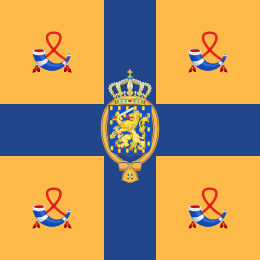Royal Palace of Amsterdam
The Royal Palace of Amsterdam in Amsterdam (Dutch: Koninklijk Paleis van Amsterdam or Paleis op de Dam) is one of three palaces in the Netherlands which are at the disposal of the monarch by Act of Parliament. It is situated on the west side of Dam Square in the centre of Amsterdam, opposite the War Memorial and next to the Nieuwe Kerk.
| Royal Palace of Amsterdam | |||
|---|---|---|---|
Koninklijk Paleis van Amsterdam Paleis op de Dam | |||
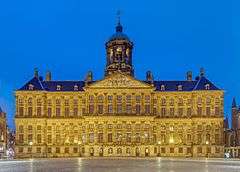 The Royal Palace of Amsterdam in 2016 | |||
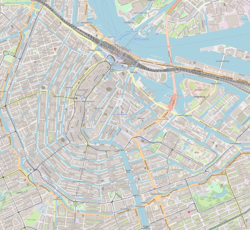 Location within central Amsterdam | |||
| Former names | Stadhuis op de Dam | ||
| General information | |||
| Architectural style | Classicism | ||
| Location | Amsterdam, Netherlands | ||
| Address | Nieuwezijds Voorburg 147 | ||
| Coordinates | 52°22′23″N 004°53′28″E | ||
| Current tenants | King Willem-Alexander | ||
| Construction started | 1648[1] | ||
| Completed | 1665 | ||
| Inaugurated | 20 July 1655 | ||
| Cost | ƒ 8.5 million | ||
| Owner | Kingdom of the Netherlands | ||
| Technical details | |||
| Floor area | 22,031 m2 | ||
| Design and construction | |||
| Architect | Jacob van Campen, Daniël Stalpaert | ||
| Other designers | Artus Quellinus, Govert Flinck, Jacob Jordaens, Jan Lievens, Ferdinand Bol | ||
| References | |||
| |||
The palace was built as a city hall during the Dutch Golden Age in the 17th century. The building became the royal palace of King Louis Napoleon and later of the Dutch Royal House.
History
Town hall
The structure was built as the Town Hall of the City of Amsterdam[2] "facing the landing wharfs along Damrak, which at that time would have been busy with ships".[3] The town hall was opened on 29 July 1655 by Cornelis de Graeff, the mayor of Amsterdam.[4] The main architect was Jacob van Campen, who took control of the construction project in 1648.[2] It was built on 13,659[2] wooden piles and cost 8.5 million gulden. A yellowish sandstone from Bentheim in Germany was used for the entire building. Marble was the chosen material for the interior.
Jacob van Campen was inspired by the Antwerp Town Hall. He wanted to build a new capitol for the Amsterdam burgomasters who thought of themselves as the consuls of the new Rome of the North. The new town hall was claimed to be the largest administrative building in Europe. In fact, some travellers described the building as too big for the city where a typical façade was only three windows wide. The technical implementation was looked after by the town construction master Daniël Stalpaert. The sculptures were executed in Antwerp by Artus Quellijn.
The interiors, focusing on the power and prestige of Amsterdam, were completed later. Paintings inside include works by Govert Flinck (who died before finishing a cycle of twelve huge canvases), Jacob Jordaens, Jan Lievens and Ferdinand Bol. Rembrandt's largest work, The Conspiracy of Claudius Civilis, was commissioned for the building, but after hanging for some months was returned to him; the remaining fragment is now in Stockholm.
Pieter de Hooch painted the interiors of the town hall in a series of the 1660s canvases, including Going for a Walk in the Amsterdam Town Hall and The Council Chamber in Amsterdam Town Hall.
Palace
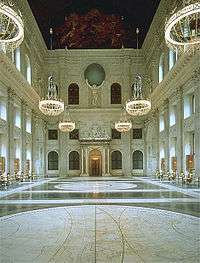
After the patriot revolution which swept the House of Orange from power a decade earlier, the new Batavian Republic was forced to accept Louis Napoleon, brother of Napoleon Bonaparte, as King Louis I of Holland in 1806. After holding his court at The Hague and Utrecht, Louis Napoleon moved to Amsterdam, and converted the Town Hall into a royal palace for himself.[2]
The King of Holland did not have long to appreciate his new palace. He abdicated on 2 July 1810;[2] his son, Napoleon Louis Bonaparte, then succeeded him, as King Louis II, before the Netherlands were annexed by France ten days later. The palace then became home to the French governor, Charles François Lebrun.
Prince William VI (son of Prince William V of Orange), returned to the Netherlands in 1813, after Napoleon fell from power, and restored the palace to its original owners. After his investiture as King William I of the Netherlands, however, Amsterdam was made the official capital of the United Kingdom of the Netherlands (the seats of government being Brussels and The Hague). The new king realised the importance of having a palace in the capital, and the Town Hall again became a royal palace.
It was made property of the Kingdom of the Netherlands in 1936.[1] On 27 December 1949, the palace's central hall (Burgerzaal) was the scene of the official ceremony for the transfer of sovereignty over Indonesia by the Netherlands (Soevereiniteitsoverdracht), represented by Queen Juliana and Indonesian vice-president Muhammad Hatta.
The palace is used by the monarch for entertaining and official functions during state visits and other official receptions, such as New Year receptions. The award ceremonies of the Erasmus Prize, of the Silver Carnation, of the Royal Awards for Painting, and of the Prince Claus Award are also held in the palace.[1]
The balcony of the Royal Palace was used during the investiture of Queen Beatrix in 1980, where her mother Juliana announced the new queen to the people.[5] The then-Prince Willem-Alexander and Princess Máxima kissed on the balcony on their wedding day on 2 February 2002 (illustrated, to the right).
The palace was renovated from 2005 until June 2009, during which, among other things, asbestos was removed. Since 14 June 2009, the palace is open again to visitors.[6]
Notable features
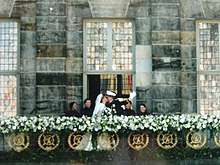
The sandstone of yellowish hue has darkened considerably in the course of time. Astride the rear of the building is a 6-metre-tall statue of Atlas carrying the Globe on his shoulders.[7] It symbolises the worldwide extent of 17th-century Dutch commerce and interests.
On top of the palace is a large domed cupola, topped by a weather vane in the form of a cog ship. This ship is a symbol of Amsterdam. Just underneath the dome, there are a few windows. From here one could see the ships arrive and leave the harbour. In the cupola is the famous carillon by François and Pieter Hemony cast in 1664 in Amsterdam. It was renovated by Eijsbouts in 1965. Only 9 bells by François and Pieter Hemony remained. 38 new bells by Eijsbouts were made and tuned in meantone temperament. The old corroded Hemony bells are kept inside the palace.
The central hall is 120 feet long, 60 feet wide and 90 feet high. On the marble floor, there are two maps of the world with a celestial hemisphere. The Western and Eastern hemispheres are shown on the maps. The hemispheres detail the area of Amsterdam's colonial influence. The terrestrial hemispheres were made in the mid-18th century. They replaced an earlier pair made in the late 1650s. The originals showed the regions explored by the Dutch East India Company's ships in the first half of the 17th century. This feature may have been inspired by the map of the Roman Empire that had been engraved on marble and placed in the Porticus Vipsania, a public building in ancient Rome.
References
- The Royal Palace, Amsterdam. The Dutch Royal House. Retrieved on 18 February 2011.
- Martin Dunford (2010). The Rough Guide to The Netherlands. Penguin. pp. 63–64. ISBN 978-1-84836-882-8.
- Berlitz (March 2017). Berlitz Pocket Guide Amsterdam (Travel Guide eBook). ISBN 9781785730238.
- Frijhoff, Willem; Spies, Marijke (2004). Dutch Culture in a European Perspective: 1650, hard-won unity. ISBN 9789023239635.
- Geert Mak, Eymert-Jan Goossens. 350 jaar geschiedenis op de Dam. Amsterdam, 2005. P. 109.
- Renovatie Paleis op de Dam in opbouwfase. Ministry of Housing, Spatial Planning and the Environment. Retrieved on 18 February 2011.
- https://www.paleisamsterdam.nl/en/discover-palace/atlas/
